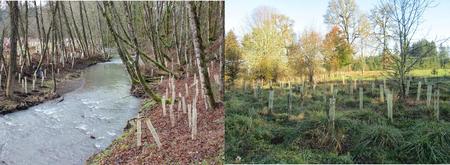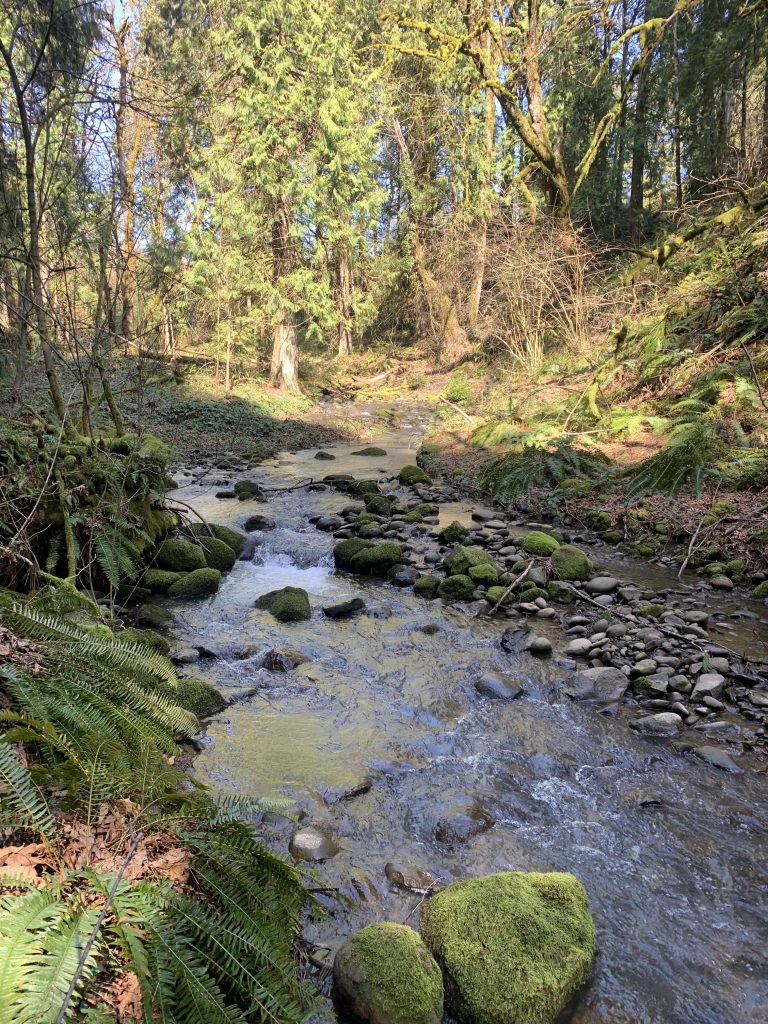Everyone has a role in shading our streams
The Clackamas River Basin Council offers streamside residents FREE weed management and native tree and shrub planting.
Shade Our Streams is unique; it brings residents, local partnerships, nurseries, volunteers and professional restoration crews together — all by planting native plants! Shade Our Streams focuses on planting along the streams that need the most help, those areas that lack healthy habitats and are overrun with invasive weeds. Native plants improve water quality, hold soils and create better habitat for plant, animal, and fish species.
So far we have restored over 30 miles of streamside habitat in the Clackamas watershed.
If you live on, or know of a streamside area overrun with invasive weeds and/or lacking shade, we want to hear from you! Please contact Eric Butler at ERIC@CLACKAMASRIVER.ORG or at 503-303-4372, Ext 104.
Meeting our goals together
Shade Our Streams impact in the Clackamas watershed
- 723,000 native seedlings planted
- 40.3 stream miles restored
- 458 Acres replanted
Program description
Shade Our Streams began as a multi-year community tree planting project to improve water quality in the Clackamas River basin. The original program was supported by Portland General Electric. We have planted more than 450,000 native plants over 10 years along over 30 stream miles, restoring streamside habitat at no cost to property owners.
Now, CRBC is continuing the Shade Our Streams program with funding from sources such as Water Environment Services, PGE Habitat Fund and others.
Where we work
We work in the Clackamas watershed in Boring, Damascus, Happy Valley, Sandy, Estacada, Eagle Creek, Redland, Viola, and parts of Gladstone and Oregon City. Streamside landowners are encouraged to give CRBC a call to find out how they can get involved!

The steps
- Contact us! – CRBC staff will begin by setting up a site visit for a one-on-one consultation with landowners to learn about interests and concerns on their property and to discuss how Shade Our Streams might help. Staff will work with landowners to create a detailed plan for restoration activities for their property.
- Site preparation – Once enrolled, site prep will include weed treatments up to 3 times per year during the spring, summer, and fall using professional restoration contractors. Several of the most aggressive weeds that we tackle include Himalayan blackberry, Japanese knotweed, English ivy, and reed canarygrass.
- Planting – Native trees and shrubs from local nurseries will be planted during winter months so that they can establish strong root systems prior to summer’s dry weather. A variety of specific plants are chosen based on site characteristics and other factors.
- Maintenance/monitoring – For two years following the initial planting, new trees and shrubs will be monitored and the weeds managed. Staff will assess the health of the planted area and make sure plants are thriving in a state where they are “free to grow”, outgrowing the invasive weeds and leaving property owners with a beautiful and functional streamside area. Landowners will receive monitoring reports with updates about their plantings.
- Ongoing education – Throughout the program, landowners will receive stewardship materials such as fact sheets (see below) as well as other educational materials to help address issues and concerns that are specific to your unique needs as a streamside landowner. Enrolled landowners also have access to additional support and resources after they have reached the “Free To Grow” stage.
Recent Program Updates

Shade Projects in the 2023-24 year
CRBC is making a major investment in the Deep Creek watershed through the latest incarnation of our Shade Our Streams program where we will restore and maintain 10 total acres.

Shade Projects in the 2022-23 year
CRBC restored 2 project sites in the 2022-23 year: A stretch of Sieben Creek in Happy Valley and a floodplain habitat along the Clackamas in Clackamas totaling in 6 acres.
